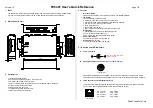
22
Instruction Booklet
IB131024EN
Effective November 2017
38 kV Type VCPW-HD Simple Electrical
Ground & Test Device (SEG&TD) lower
terminal instruction booklet
EATON
www.eaton.com
SECTION 4: INITIAL INSPECTION AND IN-
STALLATION
4 1 INTRODUCTION
WARNING
BEFORE PLACING THE CIRCUIT BREAKER IN SERVICE, CAREFULLY FOLLOW
THE INSTALLATION PROCEDURE GIVEN BELOW. NOT FOLLOWING THE
PROCEDURE CAN FAIL TO UNCOVER SHIPPING DAMAGE THAT MAY
RESULT IN INCORRECT CIRCUIT BREAKER OPERATION LEADING TO DEATH,
BODILY INJURY, AND EQUIPMENT DAMAGE.
Before attempting to place a circuit breaker in service, it should be
carefully examined and operated manually and electrically. In addi-
tion, carefully examine the breaker for loose or obviously damaged
parts. The following information is a guide for performing recom-
mended checks and tests.
CAUTION
BEFORE INSERTING THE CIRCUIT BREAKER EXAMINE THE INSIDE OF
THE CELL STRUCTURE FOR EXCESSIVE DIRT OR ANYTHING THAT MIGHT
INTERFERE WITH THE CIRCUIT BREAKER MOVEMENT.
WARNING
EXTREME CAUTION MUST BE EXERCISED TO INSURE THAT PRIMARY
CIRCUITS ARE NOT ENERGIZED WHILE CHECKS ARE PERFORMED IN THE
CIRCUIT BREAKER COMPARTMENT. FAILURE TO DO SO MAY RESULT IN
PERSONAL INJURY OR DEATH.
The circuit breaker is normally tested electrically in its cell structure
in the TEST position. To achieve the TEST position, the circuit breaker
must first be placed in the cell structure and the secondary contacts
engaged. To complete this testing procedure, the operator should
first be familiar with inserting and removing the circuit breaker into
and from the cell structure.
WARNING
DO NOT PULL ON OR USE THE MAIN (PRIMARY) CONDUCTORS AND OR
THE PRIMARY DISCONNECTS TO MANEUVER THE CIRCUIT BREAKER IN
ANY FASHION. FAILURE TO COMPLY WITH THIS CAUTION COULD RESULT
IN SIGNIFICANT EQUIPMENT DAMAGE. .
4-8.1 CIRCUIT BREAKER INSERTION AND REMOVAL
The drawout VCPW-HD circuit breaker is designed to be in one of
three different positions within the structure with the door closed,
DISCONNECT, TEST and CONNECT. Before inserting the breaker into
the structure be sure that the cell secondary slider is in the front
most position. (See Section 5-4.3) While in the structure, the circuit
breaker should never be allowed to remain in an intermediate posi-
tion between the TEST and CONNECT positions.
a) DISCONNECT POSITION: (See Figures 4-3 to 4-5)
Position the circuit breaker squarely in front of the structure.
Integrally mounted wheels facilitate circuit breaker movement out-
side of and into the structure. Once the side mounted circuit breaker
alignment rollers are aligned with the structure mounted alignment
rails, pull the shoot bolt handles in to retract the shoot bolt pins on
the side of the breaker. Then push the breaker into the structure until
the pins line up with the first set of slots in the cell rail blocks.
b) TEST POSITION: (See Figures 4-3, 4-4 & 4-6)
Pull the shoot bolt handles in, which will remove the retractable
pins from the first set of slots in the structure alignment rail blocks
and then push the circuit breaker in until the pins line up with the
second set of slots. Then release the shoot bolt handles making sure
handles return back to their outer most position. If handles are not in
outer most position the breaker will not be able to be racked in.
Immediately after insertion into the TEST position (while the motor
is still running) pull the secondary ring handles to ensure secondary
connection is fully made. (See Section 5-4.3.)
c) CONNECT POSITION: (See Figure 4-7 & 4-8)
To move the circuit breaker from the TEST to CONNECT position,
the breaker must be open. Insert the levering in crank socket onto
the square racking screw on breaker, push in firmly to release the
screw rotational interlock and begin turning the handle in a clockwise
direction. If using a motor racking device, ensure that the rotational
interlock is released with the door closed and motor installed prior
to racking. When the circuit breaker reaches the CONNECT position,
the racking screw will stop turning. The torque limiter on the racking
device will slip to prevent damage to the circuit breaker.
When FULLY in the CONNECT (and TEST) positions the square end
of the racking screw on the breaker will be in a diamond shape.
Secondary switches are driven by the screw position for both
CONNECT and TEST positions so it must be fully rotated in both
positions. (See Figure 4-2.)
Figure 4-2. VCPW-HD Racking Screw rotational position when
fully in CONNECT & TEST positions.
To remove the circuit breaker from the structure, reverse the proce-
dure just described by turning the levering crank in a counterclock-
wise direction. Keep in mind that you cannot remove a breaker from
the CONNECT position if it is closed.











































